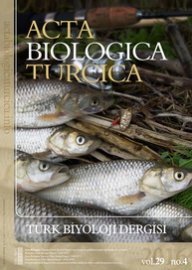Investigations on morphology of the European Hornet (Vespa crabro) nest and biological development situations of the larvae
Abstract
In this study, the nest morphology of the bee species of Vespa crabro (Linnaeus, 1758), known as the European Giant Hornet has been studied and illustrated. It was found that the nests had an approximate height of 33-60 cm, a diameter of 20-40 cm and 3-9 floors, and cells on each floor. It has been found that a thin and fragile board of wood is constructed from the stems of plant fibers and bees own saliva. It was also found that the larvae - young individuals were present at the same time in the cells of the comb, where the biological progression (instar phases) was identical. As a period of three years of observations and analysis, it has been found that the bees do not have the same old nest and the nest size is not the same, which is thought to be due to weather conditions, seasonal changes and plant flora.
Keywords
Full Text:
PDFReferences
Akre R.D., Green A., Mac Donald J.F., Landot P.J., Davls H.G. 1981. The yellow jackets of America North of Mexico. U.S. Department Agric, Agricultural Handbook No 552, Washington D.C.
Bağrıaçık N. 2011. Determination of some structural features of the nest paper of Vespa orientalis Linnaeus, 1771 and Vespa crabro Linnaeus, 1758 (Hymenoptera: Vespinae), Archives of Biological Sciences Belgrade, 63: 449-455.
Bağrıaçık N. 2012. Comparison of the nest materials of Polistesgallicus (L.), Polistes dominulus (Christ) and Polistesnimpha (Christ) (Hymenoptera: Vespidae). Archives of Biological Sciences Belgrade, 64: 1079-1084.
Bağrıaçık N. 2013a. Some structural features of the nest materials of Dolichovespula Sylvestris (Scopoli, 1763) and Dolichovespula media (Retzius, 1783) (Hymenoptera: Vespidae). International Conference on Environmental Science and Technology, Cappadocia Nevsehir, Turkey.
Bağrıaçık N. 2013b. Some structural features of nest materials of Polistesnimpha (Christ, 1791) in several ecological conditions (Hymenoptera: Vespidae). Journal of Entomological Research Society, 15: 1-7.
Carpenter J., Greene A., Caron D.M. 1980. The common names of social wasps. Bulletin of the Entomological Society of America, 26: 126-130.
Carpenter J.M. 1987. Phylogenetic relationships and classification of the Vespinae (Hymenoptera: Vespidae). Systematic Entomology, 12: 413-431.
Carpenter J.M. 1991. Phylogenetic relationship and the origin of social behavior in the Vespidae. In: K.G. Ross, R.W. Matthews (Eds). The Social Biology of Wasps. Comell University Press. pp: 7-32.
Cole M.R., Hansell M.H., Seath C.J. 2001. A quantitative study of the physical properties of nest paper in three species of Vespinae wasps (Hymenoptera, Vespidae). Insectes Society, 48: 33-39.
Edwards R. 1976. The world distribution pattern of the German wasp, Paravespula germanica (Hymenoptera: Vespidae). Entomologica Germanica, 3: 269-271.
Evans H.E., Eberhard W.M. 1970. The Wasps. Michigan Univ. Press, USA, 265 p.
Greene A. 1991. Dolichovespula and Vespula. In: K.G. Ross, R.W. Matthews (Eds). the Social Biology of Wasps. Cornell Univ. Pres, pp: 263-304.
Kudô K., Yamane S.O., Mateus S., Tsuchida K., Ito Y., Miyano S., Yamamoto H., Zucchi R. 2001. Nest materials and some chemical characteristics of nests of a New World swarm-founding polistine wasp, Polybia paulista (Hymenoptera Vespidae). Ethology Ecology and Evolution, 13: 351-360.
James M.C. 1987. Phylogenetic relationships and classification of the Vespinae (Hymenoptera: Vespidae). Systematic Entomology, 12: 413-431.
Matsuura M. 1974. Intracolonial polyethism in Vespa. The Entomological Society of Japan, Kontyu, Tokyo. 42(3): 333-335.
Kekeçoglu M. 2007. Türkiye bal Arılarının mtDNA ve bazı morfolojik özellikleri bakımından karşılaştırılmasına yönelik bir araştırma, Doktora Tezi Zootekni Anabilim Dalı. T.C. Namık Kemal Üniversitesi Fen Bilimleri Enstitüsü.
Özbay C. 1992. Diyarbakır, Mardin ve Sanlıurfa il sınırları içinde yaşayan Vespoidea (Insecta: Hymenoptera) üst familyasına bağlı türlerin sistematiği, dağılışı ve biyometrik özelliklerinin araştırılması. Doktora Tezi, Dicle Üniversitesi, 81 s.
Özbek H. 1983. Vespidae (Hymenoptera) türlerinin zararları ve korunma yolları. Atatürk Üniversitesi Ziraat Fakültesi Dergisi, 14(3): 149-156.
Richards O.W. 1971. The biology of social wasps (Hymenoptera: Vespidae). Biological Rewievs, 46: 483-525.
Schmitz J., Moritz R.F.A. 1990. Mitochondrial DNA variation in social wasps (Hymenoptera: Vespidae). Experientia, 46: 1068-1072.
Spradbery S.P. 1973. Wasps. An Account of biology and natural history of the solitary and social wasps. Sidgwick and Jackson Publishing, London. 408 p.
Steinmetz I., Sieben S., Schmolz E. 2002. Chemical trails used for orientation in nest cavities by two vespine wasps, Vespa crabro and Vespula vulgaris. Insectes Sociaux, 49: 354-356.
Tanyolaç T. 1964. Ankara çevresinde sosyal halde yaşayan Vespidae (Hymenoptera) türleri ve bunlardan Polistes gallicus L.’un biyolojisi üzerinde arastırmalar. Doktora tezi, Fen Fakültesi, Biyoloji Bölümü, Ankara Üniversitesi, 46 s.
Tüzün A., Tanyolaç T. 1987. Ege bölgesi Vespidae (Insecta: (Hymenoptera) türlerinin saptanması. Fen Edebiyat Fakültesi, Celal Bayar Üniversitesi, Fen Bilimleri Dergisi, 5(2): 147-171.
Tüzün A. 1995. Polistes (s.str.) gallicus’ta (Insecta: Hymenoptera) Yuva Oluşumu ve yuvadaki bireylerin morfolojik özellikleri. Fen Edebiyat Fakültesi, Celal Bayar Üniversitesi, Fen Bilimleri Dergisi, 18: 102-113.
Varvio-Aho S.L., Pamilo P., Pekkarinen A. 1984. Evolutionary genetics of social wasps (Hymenoptera, Vespidae, Vespula). Insectes Sociaux, 31: 375-386.
Yıldırım E., Özbek H. 1992a. Vespidae (Hymenoptera: Vespoidea)’da iğne, zehirin yapısı ve fonksiyonu. Doğu Anadolu Bölgesi I. Arıcılık Semineri, Erzurum. pp: 168-181.
Yıldırım E., Özbek H. 1992b. Türkiye Vespinae (Hymenoptera: Vespoidea: Vespidae) türleri üzerinde sistematik ve faunistik çalısmalar. Türk Entomoloji Dergisi, 16(4): 227-242.
Yıldırım E., Özbek H. 1993. Polistinae (Hymenoptera: Vespidae) of Turkey. Türk Entomoloji Dergisi, 17(3): 141-156.
Yıldırım E., Özbek H. 1996. Zaralıları baskı altında tutmada vespoidea (Hymenoptera) türlerinin önemi. Atatürk Üniversitesi Ziraat Fakültesi Dergisi, 27(3): 439- 447.
Yıldırım E. 1996. Türkiye’de bulunan bazı Vespidae (Hymenoptera: Vespoidea) türlerinin yuvalarının yapısı üzerinde çalışmalar. Atatürk Üniversitesi Ziraat Fakültesi Dergisi, 27(4): 517-523.
Von Hagen H.H. 1987. Wissenswertes über unsere Hornisse (Vespa crabro L.). ADIZ, 4: 109-112.
Refbacks
- There are currently no refbacks.

